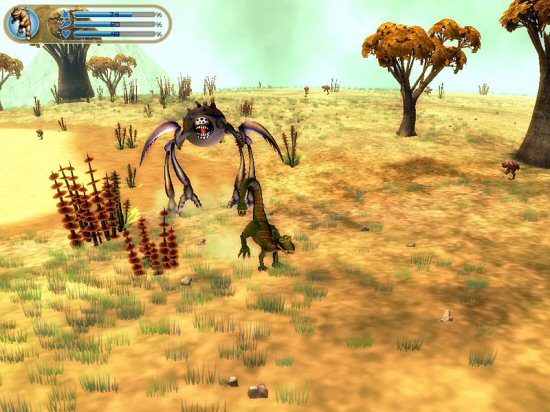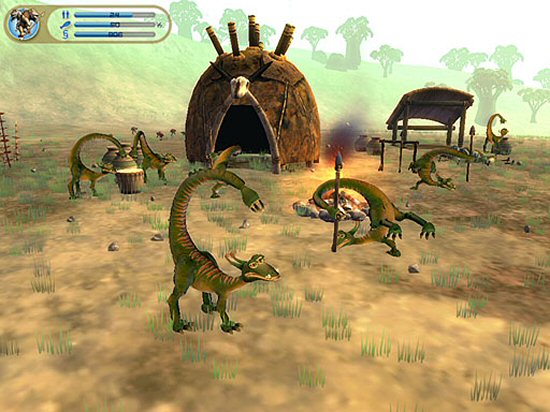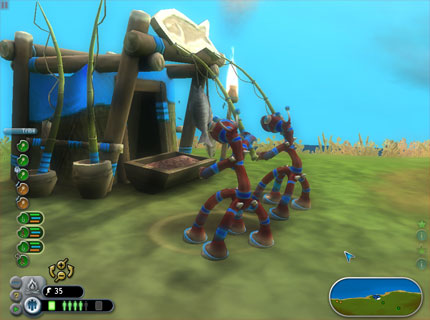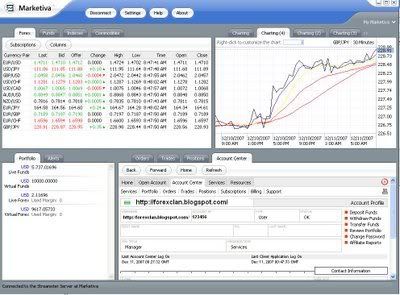
Spore is a multi-genre massive single-player online metaverse video game developed by Maxis and designed by Will Wright. It allows a player to control the evolution of a species from its beginnings as a unicellular organism, through development as an intelligent and social creature, to interstellar exploration as a spacefaring culture. It has drawn wide attention for its massive scope, and its use of open-ended gameplay and procedural generation.
The full version of the game was released on September 4, 2008, in Australia and the Nordic region, but Australian stores prematurely broke the street date on September 2, 2008. The game was released September 5, 2008 in Europe, Japan, South America and New Zealand, and was released on September 7, 2008 in North America and Asia Pacific territories. Spore is also available for direct download from Electronic Arts. A special edition of the game, Spore: Galactic Edition, additionally includes a "Making of Spore" DVD video, "How to Build a Better Being" DVD video by National Geographic Channel, "The Art of Spore" hardback mini-book, a fold-out Spore poster and a 97-page Galactic Handbook published by Prima Games.
The name Spore was originally a working title, suggested by developer Ocean Quigley, for the game which was first referred to by the general public as Sim Everything. Even though Sim Everything was a first choice name for Wright, the title Spore stuck. Wright added it also freed him from the preconceptions another Sim title would have brought, saying "...Not putting 'Sim' in front of it was very refreshing to me. It feels like it wants to be breaking out into a completely different thing than what Sim was."
Civilization IV lead designer Soren Johnson joined EA Maxis to work on Spore.
The procedurally-generated music for the game was designed by Brian Eno, an artist famous for his work with ambient music. The music is generated by the editors depending on which parts (eg: limbs, battle items, hands, feet, etc) are placed on the creature, vehicle or building. For example, something dangerous like a battle spike will give the music more of a ferocious feel, while something peaceful like a herbivore's mouth will give the music a more relaxed feel. Music can also be created by users in the form of a short national anthem for their tribe, civilization or empire.
Gameplay
Coined Creatiolutionism, the game allows the player to develop a species from a microscopic organism to its evolution into a complex animal, its emergence as a social, intelligent being, to its mastery of the planet and then finally to its ascension into space, where it interacts with alien species across the galaxy. Throughout the game, the player's perspective and species change dramatically.
The game is broken up into distinct yet consistent, dependent "phases". The outcome of one phase affects the initial conditions facing the player in the next. Each phase exhibits its own style of play, and has been described by the developers as ten times more complicated than its preceding phase. While players are able to spend as much time as they prefer in each, it is possible to accelerate or skip phases altogether. Some phases feature optional missions; when the player completes a mission, they are granted a bonus, such as a new ability.
If all of a player's creations are completely destroyed at some point, then that player's species will be respawned at its home base.
Unlike many other Maxis games, Spore has a primary win condition which is obtained by reaching a quasar placed in the center of the galaxy, and facing a large NPC race. However, the player may continue to play after the goal has been achieved.
Community
Spore's user community functionality includes a feature that is part of an agreement with YouTube granting players the ability to upload directly from within the game a YouTube video of their creatures' activity, and EA's creation of "The Spore YouTube Channel", which will showcase the most popular videos created this way. In addition, some user-created content will be highlighted by Maxis at the official Spore site, and earn badges of recognition for their work. One of Spore's most social features is the Sporecast, an RSS feed that players can use to subscribe to the creations of any specific Spore player, allowing them to track their creations.
There will be a parental control toggle which allows the player to restrict what downloadable content will be allowed; choices include: "no user generated content", "official Maxis-approved content", "downloadable friend content" (named "buddy" in the final game), and "all user-created content". Players can also ban any creature in-game, at any time, and Maxis monitors creatures with notable numbers of player bans.
Interplay
The game is referred to as a "massively single-player online game" and "asynchronous sharing." Simultaneous multiplayer gaming is not a feature of Spore. The content that the player can create is uploaded automatically to a central database (or a peer-to-peer system), cataloged and rated for quality (based on how many users have downloaded the object or creature in question), and then re-distributed to populate other players' games. The data transmitted will be very small — only a couple of kilobytes per item transmitted. This was due to procedural generation of material.
After reaching the space phase, players can visit other players' planets, and interact with other players' species, tribes and civilizations. . Via the in-game "MySpore Page", players receive statistics of how their creatures are faring in other players' games, which has been referred to as the "alternate realities of the Spore metaverse." The game reports to the player on how other players interacted with them (for example, how many times other players exterminated their species). The personalities of user-created species are dependent on how the user played them.
Start of life
The game opens using the scientific concept of panspermia. A meteor plummets toward a planet and into an ocean. The meteor, now a geode, then splits, from which a tiny organism emerges.
Cell
The first phase of existence, the cell phase, is sometimes referred to as the tide pool, cellular, or microbial phase. The player guides simple microbes around in a 3D environment on a single 2D plane, reminiscent of flow, where it must deal with fluid dynamics and predators, while eating weaker microbes or plants. The player may choose whether the creature is a herbivore or a carnivore prior to starting the phase. Once the microbe has eaten several cells, the player can enter an editor in which they can modify the appearance, shape, and abilities of the microbe by spending "DNA points". A player may choose to remove a part, which will refund the full price. If the creature dies, the player restarts from wherever it died. The player must also seek out special "golden shields" from meteor fragments and other organisms that provide new parts to use in the editor, such as spikes, mouths or limbs. The phase consists of five stages, which are halved themselves; every half-stage, the creature grows larger. As the microbe grows, objects that are in the background move to the foreground, which can mean being eaten by a microbe that had previously been swimming in the background.
The player may also encounter Epic Creatures. An epic creature is a larger, tougher version of its normal counterpart. In later phases, it is actually user-created content that is increased to giant size.
The creature's behavior directly influences its role in the creature stage, and only parts that are fitting for that creature's evolution will become available. The ocean floor becomes more prominent as the player progresses, and once the player decides to progress to the next stage, the creature editor appears, prompting the user to add legs before the shift to land.
At the end of the phase, the player receives one special "bio-power" in each later phase based on whether the creature ended the phase as a herbivore, carnivore or omnivore. For instance, herbivores are given the "Siren's Song" power in the Creature phase.
Creature
The creature phase is similar to the cell phase, but with several important differences. Principally, the environment is now truly 3D. Other creatures will inhabit the world, and most of them will have been created by other players. Creatures will automatically be introduced into the environment to maintain a balanced ecosystem. If the player creates a bigger, tougher creature, the predators that are downloaded will likewise be stronger than average.
In this stage, the basic goal is the same: earn DNA points, reproduce, and avoid being eaten by predators. In order to reproduce the player must locate a mate.
Another difference introduced is the social aspect which provides means by which a player can earn DNA points. Socialization is the nonviolent alternative to consuming creatures for DNA, as befriending other creatures earns DNA points, allows access to their nests for resting, and makes them allying against attack more likely.
Every time the player interacts with a creature, the game will create a quest depending on what stance is used. If the player is in a social stance, it will give them the goal of befriending a certain number of that species. If they are in combat stance, the goal will be to kill a certain number of that species, and therefore, render that species extinct. If the player's creature kills off or befriends a species, the creature will be able to heal at their nest.
Creatures have stats for Abilities, Attack, and Social, using a numeric rating system. Adding specific body parts grants the ability to perform actions, such as "Call" and "Jump". Creatures can be given a name, description and tags. Body parts can be found during gameplay, which add that part to the editor for future use. These come from preying upon alpha creatures, finding bones of dead creatures, and socializing with other creatures. The only body part a creature requires is a mouth (or it will starve to death). If a creature has no feet, it will slide across the ground with the lower section of the torso, in a similar fashion to a slug or worm. Creatures also may have a limited ability to fly: gliding. A creature's ability to stay aloft is dependent on two factors: the jumping ability (how high in the air) and gliding ability (how slow the descent is). Also, a creature may have the ability to sneak, sprint, charge or spit poison.
This stage will evolve the creature's social behavior, as the creature may make friends and form a herd or pack. Will Wright referred to this as a simplified version of the friend-making mini-game in The Sims. This mini-game is implemented by mimicking the other creature's behavior such as singing or dancing until their level of friendship with the player's creature rises. Creatures may also make friends with other species. The player may also encounter spaceships from other players from this phase onward, which may abduct the player or other creatures. The evolutionary goal of the creature phase is to increase the creature's brain capacity which is done by gaining DNA points. Once the creature becomes intelligent, the player may progress to the tribal phase.
The creature phase has night and day cycles, with very short nights. There are also weather effects such as short rainstorms and meteor showers.
Tribal
After the player's species evolves its brain far enough, it enters the tribal phase. Physical development ceases, as does the player's exclusive control over an individual creature, as the game focuses on the birth of division of labor for the species. The player is given a hut, a group of fully evolved creatures, as well as two of six possible "super powers". These are unlocked depending on the species' behavior in the previous phases.
This stage begins with a cutscene parodying 2001: A Space Odyssey. In this phase, the game is similar to an RTS (real-time strategy game). The player may give the tribe tools such as weapons, musical instruments, and healing or fishing implements. Food now replaces "DNA points" as the player's currency, which the player can spend on items and structures, or use to barter with other tribes. Creatures also gain the option to wear clothes, the editing of which replaces the Creature Editor in the 'Tribal Editor'. If creatures of a different species (Rogues) were added to the player's pack in the Creature phase, they are now used as pets. Additional creatures may be domesticated in the Tribal phase, which provide eggs for food. Contact with other tribes of the same species, or even different species, can take place in this phase, and creatures also learn to speak. Their language is dependent on the type of mouth they possess; primate-type mouths, for instance, result in Simlish. Creatures, as with The Sims, also "speak" with icons embedded in word balloons.
Tribe members are assigned roles such as fishing, gathering, or hunting. The creatures' behaviors are affected by the way the player utilizes them. If a player uses them aggressively, their autonomic behavior will reflect that; conversely, if the player uses them peacefully, allying other tribes, say, with music, their behavior will be more kind. Even their idle behavior will reflect this; warlike tribal members will practice combat while docile members will practice instruments and throw parties.
There are five other tribes along with the player's, which can either be destroyed or befriended. For every tribe befriended or destroyed, a piece of a totem pole is built, which may increase the population limit of the player's tribe. When the totem pole has five pieces, the player may move forward to the Civilization phase.
Civilization
The goal in the civilization phase is to gain control of the entire planet, and it is left to the player to decide whether to conquer it militarily, economically, or religiously. When entering the phase, the player's tribal camp is now a city. Players now have two new editors: the building and vehicle editors. The player can build four buildings (City Hall, House, Factory, and Entertainment) and up to 9 vehicles (Religious, economic, and military in sea, land and air). To earn income, players can capture spice gysers, conduct trade, or arrange buildings (see below).
In constructing vehicles and buildings, as with most real-time strategy games, there is a capacity limit; building houses will increase the cap, and constructing various buildings adjacent to one another will provide a productivity bonus or deficit: for example, building an entertainment centre next to a house will provide happiness, but a factory will decrease happiness and increase production. Like Civilization III and IV, the player's territory is marked with a colored border that increases as the player gains more power through militarism or influence. The main unit of currency is "Sporebucks".
Instead of military conquest, players with a Religious trait construct special missionary units that convert other cities via propaganda. Likewise, Economic players communicate solely by trade and have no weapons. Players also have access to superweapons, each of which have devastating effects on other rival civilizations. Players can also form alliances with a rival civilization, and when the entire world has been conquered by both factions, the rival faction will join the player's.
When the player has conquered or allied with all the civilizations on the planet and decides to move on to the Space Phase, the UFO editor appears. At this point players are allowed to view the planet from space.
Space
The space phase provides new goals and paths to follow as the player begins to spread through the galaxy.
The player may now terraform and colonize neighboring uninhabitable planets with special tools (water tool, volcano tool, etc). Although these tools start off limited and very expensive, the player can obtain infinite versions. Terraforming tools include a heat ray which can create more favorable conditions on, for example, an ice planet. Left unchecked this can cause oceans to rise, then eventually to evaporate and transform the world into a desert planet, followed by a molten rock in space. These tools may also be used as weapons, sucking out the atmosphere or altering the temperature of a planet in order to kill the inhabitants without a pitched battle. The ultimate terraforming tool is a technology called the Staff of Life, dubbed the 'Genesis device' prior to the game's release, which instantly transforms a dead world into a habitable one, although it is limited to 42 uses.
The player may cause ice comets to crash into a planet to create water, or force volcanoes to erupt to increase atmosphere. Players may build colonies on the surface of an inhospitable planet once they gain the ability to create bubbled cities, similar in function to self-sustaining arcologies. When establishing colonies on alien worlds, players have to take care of them as they would any other city and keep morale up.
The player may also abduct creatures and transport them to other planets to test a planet's habitability (During earlier phases of the game, it is possible to see other creatures on the planet being abducted for this or other purposes.) The player may utilize various tools such as fireworks to interact with primitive lifeforms, or place a monolith (in the style of 2001: A Space Odyssey) on a planet, triggering evolution of intelligence. On some worlds, the player may also find strange "artifacts" with functions varying from terraform coloring tools to treasures which can be sold for a relatively large price. Artifacts can be present on lifeless worlds and inhabited worlds, although taking them from planets occupied by sentient beings will anger them.
There are more than 50,000 planets in the game's galaxy (including Earth and the Solar System).
Players can make contact with other civilizations, called 'empires', most of which are created by other players. Intelligent species can be found, and when the UFO visits that world, they may impress the beings with fireworks or a 'happy ray', attack them with weapons, or cast crop circles. The player may beam down a holographic image of his/her creature to interact more directly with an alien species. A user-created civilization's AIl reacts depending on its behavior and personality, both of which are based on the play-style of its user. The player can unite or conquer the galaxy by creating a federation or sparking an interstellar war. As a show of great force, the player may even completely destroy a planet (similar to the capabilities of the Death Star from Star Wars), which may bring retribution from that species and its allies. The player is sometimes called upon to fight off an invasion of their home planet, colony, or an ally's planet, from space pirates, environmental collapse, or attack from enemies.
EA has stated that there will be a storyline and 'secret ending' which can be found within the Space stage, and that 'only the most hardcore gamers' will find it, which is some kind of energy source in the middle of the galaxy guarded by the Grox.
Sandbox
The space phase is sometimes referred to as a sandbox, because the player eventually gains near-complete control of everything, though in the initial stages of the Space phase, the player inevitably must interact with other civilizations as in previous stages. It has been mentioned that the space phase works on two axes: a horizontal axis (the ability to interact with many planets in a variety of different ways) and a vertical axis (the ability to revisit different phases of gameplay).
Editors
User-generated content is a major feature of Spore; there are eighteen different types of editors (some unique to a phase), and even a music editor which allows players to create and share songs to be used as a national anthem in the Civilization stages and above. Will Wright has stated that in addition to being simple, all the editors will be as similar as possible so that skills learned are easily transferable from one editor to the next.
The editors start simply in the cellular phase and move to higher levels of complexity, acting as tutorials for progressive levels of gameplay. For example; the cell editor demonstrated so far has nine choices and a two-dimensional environment while the creature editor has dozens of options and a 3D environment. The structure ranges from a spine and body model in the creature editor to more free-form editors for the buildings.
For example, the creature editor allows the player to take what looks like a lump of clay with a spine and mold it into a creature. Once they have molded the torso, they can then add parts such as legs, arms, feet, hands, noses, eyes, mouths, decorative elements, and a wide array of sensory organs. Many of these parts affect the creature's abilities (speed, strength, diet, etc.), while some parts are purely decorative. Once the creature is formed, they can paint it using a large number of textures, overlays, colors, and patterns, which are procedurally applied depending on the topology of the creature. The only "required" feature is the mouth (otherwise, the creature will die from starvation). All other parts are optional; for example, creatures without feet will, as said before, slither on the ground like a snake or slug.
Other editors are used for buildings and for vehicles. Eventually, players can edit entire planets, using various in-game processes. Electronic Arts has promised new editors to be released after the game's release, such as a flora editor. However, a beta flora editor and expanded cell editor are available in the game code and can be accessed by changing the target parameters for the shortcut executable.
There are also simple means of creating visual media: such as a screenshot facility that captures the screen without the surrounding user-interface; and a 640x480 video creator with a built-in YouTube upload service. Maxis has also partnered with a third-party to provide a Spore-branded Comic Book Creator service, which was live at launch.
Spore E308 Trailer









0 评论 for this post